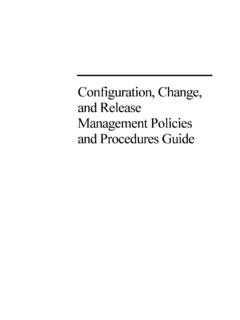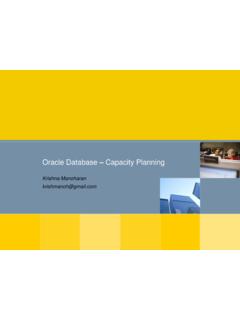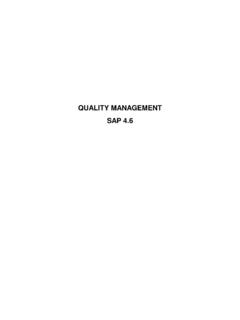Transcription of Facilities Management Policy and Procedures - Processdox
1 Facilities ManagementPolicy and ProceduresInitial DraftThis document contains trade secrets and proprietary information belonging to <company name> International. No use or disclosure of the information contained herein is permitted without the prior written consent of <company name> International.<company name>All rights reservedAll trade names, trademarks, or registered trademarks are trade names, trademarks, or registered trademarks of their respective computer file for this document is owner of this document is .Document ReviewReview MilestoneDateCommentsPeerPreliminary Design Review (PDR)Critical Design ReviewAcceptance ReviewReleaseDocument RevisionsVersionDateRevisionsInitial Draft5/26/00 Initial Draft<company name> Table of Contents1 Facilities Management ROLES AND DEVELOPING BASELINE MANAGING COMPLIANCE AND CORRECTIVE DEVELOPING BASELINE MANAGING COMPLIANCE AND CORRECTIVE Risk and Impact RELIABILITY, COST AND SERVICE MEAN-TIME-BETWEEN FAILURE MEAN-TIME-TO-REPAIR SERVICE LEVEL AGREEMENT WARRANTY SERVICE LEVEL EXPECTED SAVINGS AND AUDITING PHYSICAL Facilities FIRE AIR ACCESS of ContentsiProcess 1 IntroductionFacilities Management addresses the maintenance and upkeep of physical Facilities .
2 This Policy and Procedures manual is focused on data center and equipment Facilities . Management OverviewEffective Facilities Management is the foundation of meeting service level objectives for operational support systems (OSS), telecommunications switching equipment and network infrastructure. These systems are the cornerstone of services offered to <company name> customers and must be housed in Facilities that safeguard their security and integrity. The following are critical success factors for Facilities Management :Table 1 - Facilities Management Critical Success FactorsCritical Success FactorConsequence of Not Meeting the Critical Success FactorCompliance with national, state and local building and fire codesFacility is at risk of being shut down by local authorities, which will cause disruption of services until all non-compliance items and discrepancies can be rectified. This event has the potential to result in revenue loss or erosion of <company name>'s customer to established standards for cabling, heating, ventilation and air conditioning (HVAC), electrical, and building characteristics (weight distribution, access, equipment placement, etc.)
3 Non-standard implementations or installations can result in diminished performance, safety hazards, fire hazards and risk to equipment due to insufficient resources with which to support the OSS, telecommunications switching equipment and network infrastructure. Additional risks include structural damage due to improper equipment weight distribution, overheating due to insufficient HVAC resources, and inability to access key systems, subsystems and components in an for risks with consequences ranging from equipment damage to injury or loss of human life. Safety is closely related to compliance with national, state and local building and fire code critical success for disaster recovery and business resumption planning, Policy and proceduresIf Facilities Management is not aligned with disaster recovery and business resumption planning there could be either duplication of effort between the functions supporting Facilities Management and disaster recovery/business resumption planning, or gaps in <company name>'s plans for both areas leaving securityThere are a number of risks and exposures to <company name>'s Facilities .
4 Specifically, all Facilities supporting OSS, telecommunications switching equipment and network infrastructure are potential targets for vandalism, theft and attacks motivated by political or special causes. Moreover, Facilities have the potential to be targets for industrial Draft<Confidential MaterialPage 1 Facilities Management Policy and intended audiences for Facilities Management processes include: Facilities manager Data center manager Network and infrastructure manager(s) Security manager Operations manager Disaster Recovery/Business Resumption Manager Internal auditorsSpecific roles and responsibilities for the intended audience of this document is provided in Section , Roles and Responsibilities. Confidential Material<Initial DraftPage 2 Process 2 PolicyThe following is <company name> Communications Policy for Facilities housing data centers, switches, other operational support systems (OSS) or network infrastructure will: Comply with national, state and local building and fire codes.
5 Comply with Americans with Disability Act (ADA) public law with respect to Facilities . Adhere to established standards for cabling, heating, ventilation and air conditioning (HVAC), electrical, and building characteristics (weight distribution, access, equipment placement, etc.). Be operated and maintained in accordance with best practices for safety. Provide support for disaster recovery and business resumption planning, Policy and Procedures . Have in place access controls, inspections and audits that are in keeping with best practices for physical security. Be routinely cleaned and maintained with respect to a clean, uncluttered and trash-free environment. Be proactively managed using a planned maintenance program and effective control over HVAC and electrical and ResponsibilitiesTable 2 - Facilities Management Roles and ResponsibilitiesRoleResponsibilityFacili ties maintenance of all physical planned maintenance for all physical a resource budget for all environmental controls and electrical systems ( , total available power and environmental resources minus equipment using these resources will provide a budget of available resources.)
6 For example, if a facility has the capability of handling 100,000 BTUs of heat dissipation to keep the Facilities at a constant 70 F and existing equipment puts out 70,000 BTUs, then the resource budget is 30,000 that all Facilities comply with all applicable codes and laws ( , building and fire codes, ADA, etc.) additional resource requirements based on inputs from the data center manager, Switch Engineering, Operations Manager and other sources of information available from business units Continued on next pageInitial Draft<Confidential MaterialPage 3 Facilities Management Policy and ProceduresTable 2 - Facilities Management Roles and Responsibilities (continued)RoleResponsibilityData center key access entry into the Facilities , including ensuring that all visitors are escorted and sign a visitor log. In the case of visitors who have been authorized to access the Facilities unescorted (third-party vendors on access lists, field engineers, etc.) that there is a record of their for enforcing security policies and Procedures , and assisting the <company name> Security Manager in identifying exposures and risks with respect to data center operations.
7 For example, challenging unauthorized personnel who enter the operational premises in violation of security Policy . , implement and manage an asset control process that provides for the identification and tracking of all physical assets under their area of cognizance. This includes serial numbers, configuration baselines, asset identification, and physical operating characteristics. Physical operating characteristics include power requirements (including stand-by power sources), BTU requirements, weight and load distribution requirements, physical interfaces (network infrastructure). the Facilities manager with physical operating characteristics for planned hardware platforms (weight, power, HVAC and special installation requirements). the Disaster Recovery/Business Resumption Manager with planning and systems tests and evaluation in support of disaster recovery and/or business resumption the network and infrastructure managers with list of required physical and logical interfaces (including protocols, TCP/IP port numbers, etc) for connecting data center assets to the <company name> intranet, the Internet or other systems to which data center equipment needs to be interfaced ( , provisioning systems to switches, etc.)
8 Network and infrastructure manager(s) the Facilities manager with physical operating characteristics for planned communications hardware (weight, power, HVAC and special installation requirements) and cabling that planned demarcations between <company name> networking and communications infrastructure and third part service providers comply with service provider interface specifications and that the interface specifications are consistent with technical standards and [any] applicable fire, safety and building policies and Procedures for physical the Facilities manager with a list of physical security devices that need to be installed and the data center manager with requirements and Procedures for maintaining physical security for the data security inspections and audits with the operations that physical operating characteristics are provided to the Facilities manager in accordance with mutually agreed upon lead compliance with physical security policies and Procedures that are established by the security manager.
9 That disaster recovery/business resumption requirements are communicated to data center, network and infrastructure, and Facilities the disaster recovery/business resumption manager with coordinating system tests and evaluations that involve Facilities and internal auditors by making Facilities and personnel available for audits with respect to on next pageConfidential Material<Initial DraftPage 4 Process Table 2 - Facilities Management Roles and Responsibilities (continued)Disaster Recovery/Business Resumption physical facility requirements that support disaster recovery/business resumption objectives ( , specifying requirements for redundant or secondary power sources, Facilities emergency access, etc.). requirements to (1) operations manager and (2) Facilities any internal audits of Facilities and/or Facilities security with the operations internal audits in accordance with <company name> corporate standards, methods and Procedures for internal auditing of Facilities and physical Draft<Confidential MaterialPage 5 Facilities Management Policy and Procedures3 ProcessFacilities Management consists of the following baseline and Baseline RequirementsBaseline requirements encompass all requirements for services and resources (HVAC, power), construction requirements, physical security devices and methods, and compliance with codes, regulations and standards.
10 This process is depicted in the following diagram:Services and ResourcesHVACP owerSource of Information:Manufacturer Manuals and specificationsConstruction RequirementsFloor TypeCodes, Regulations and StandardsFire SurpressionSafetySource of Information: National, State and Local Code Construction Standards Safety Standards Manufacturer Manuals andspecificationsPhysical SecurityAccess Control DevicesMonitoring and Auditing DevisesAdministrative MethodsSource of Information:Policies and ProceduresRisk Mitigation MeasuresBest Practices and Industry StandardsBaselineRequirementsConfidentia l Material<Initial DraftPage 6 Process ResourcesThis sub process begins with the baseline, which should be designed to accommodate initial requirements for construction, services and resources, and physical security. As additional requirements emerge, such as adding services, network infrastructure, modified security standards, etc., an impact analysis is performed to determine if the baseline can support the new requirements.



